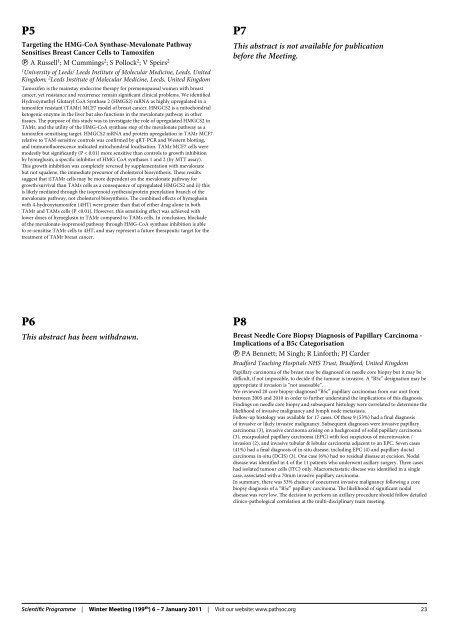Winter Meeting 2011 - The Pathological Society of Great Britain ...
Winter Meeting 2011 - The Pathological Society of Great Britain ...
Winter Meeting 2011 - The Pathological Society of Great Britain ...
Create successful ePaper yourself
Turn your PDF publications into a flip-book with our unique Google optimized e-Paper software.
P5<br />
Targeting the HMG-CoA Synthase-Mevalonate Pathway<br />
Sensitises Breast Cancer Cells to Tamoxifen<br />
P A Russell 1 ; M Cummings 2 ; S Pollock 2 ; V Speirs 2<br />
1 University <strong>of</strong> Leeds/ Leeds Institute <strong>of</strong> Molecular Medicine, Leeds, United<br />
Kingdom; 2 Leeds Institute <strong>of</strong> Molecular Medicine, Leeds, United Kingdom<br />
Tamoxifen is the mainstay endocrine therapy for premenopausal women with breast<br />
cancer, yet resistance and recurrence remain significant clinical problems. We identified<br />
Hydroxymethyl Glutaryl CoA Synthase 2 (HMGS2) mRNA as highly upregulated in a<br />
tamoxifen resistant (TAMr) MCF7 model <strong>of</strong> breast cancer. HMGCS2 is a mitochondrial<br />
ketogenic enzyme in the liver but also functions in the mevalonate pathway in other<br />
tissues. <strong>The</strong> purpose <strong>of</strong> this study was to investigate the role <strong>of</strong> upregulated HMGCS2 in<br />
TAMr, and the utility <strong>of</strong> the HMG-CoA synthase step <strong>of</strong> the mevalonate pathway as a<br />
tamoxifen-sensitising target. HMGCS2 mRNA and protein upregulation in TAMr MCF7<br />
relative to TAM-sensitive controls was confirmed by qRT-PCR and Western blotting,<br />
and immun<strong>of</strong>luorescence indicated mitochondrial localisation. TAMr MCF7 cells were<br />
modestly but significantly (P < 0.01) more sensitive than controls to growth inhibition<br />
by hymeglusin, a specific inhibitor <strong>of</strong> HMG-CoA synthases 1 and 2 (by MTT assay).<br />
This growth inhibition was completely reversed by supplementation with mevalonate<br />
but not squalene, the immediate precursor <strong>of</strong> cholesterol biosynthesis. <strong>The</strong>se results<br />
suggest that i)TAMr cells may be more dependent on the mevalonate pathway for<br />
growth/survival than TAMs cells as a consequence <strong>of</strong> upregulated HMGCS2 and ii) this<br />
is likely mediated through the isoprenoid synthesis/protein prenylation branch <strong>of</strong> the<br />
mevalonate pathway, not cholesterol biosynthesis. <strong>The</strong> combined effects <strong>of</strong> hymeglusin<br />
with 4-hydroxytamoxifen (4HT) were greater than that <strong>of</strong> either drug alone in both<br />
TAMr and TAMs cells (P













